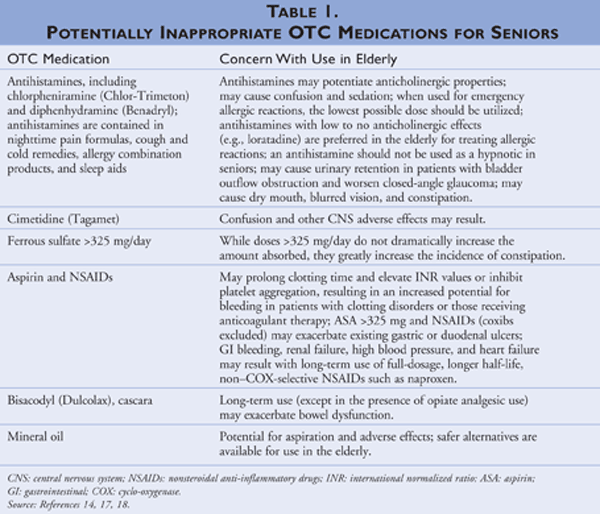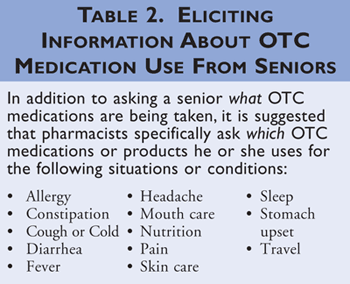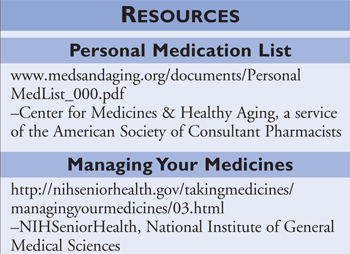Self-medication with OTC products is an economical method of treatment for common self-limiting illnesses.1 As more and more prescription medications are approved for OTC availability, provision for greater choice for individuals and potential savings in government spending on health care further expands the OTC market for the pharmaceutical industry.2 As pharmacists, however, are we acknowledging the mutual responsibility for communication between patients and health professionals regarding the use of OTCs?2 Are we aware that use of OTC medications is sure to become an increasing problem in seniors as the trend to deregulate prescription medication continues?3 Health care professionals, providers, government regulatory agencies, and the pharmaceutical industry, in a concerted effort, need to take responsibility for setting in place dynamic systems to ensure a safe and effective increased use of OTC medications by seniors.2
As the population of older adults continues to rise, the need to monitor how elderly individuals use these increasingly available OTC medications increases as well.1 This need becomes alarmingly evident when research tells us that on any given day, 20% to 30% of older adults take an analgesic medication and more than 60% of these individuals cannot identify the active ingredient in their brand of pain reliever.4 Furthermore, approximately 40% of Americans believe that OTC medications are too weak to cause any real harm.4 At recommended doses and for intermittent use, OTC analgesics are generally effective and well tolerated; at inappropriate higher doses or use in individuals with contraindications, long-term use of analgesics raises the risk for adverse effects, such as gastrointestinal bleeding and renal, hepatic, and cardiovascular toxicity, especially in the elderly.4 Clearly, when seniors self-medicate with OTCs they can complicate and compound the risk of potential medication-related problems due to underlying comorbidities and the frequent need for multiple-drug regimens, increasing the vulnerability for drug-drug interactions (TABLE 1).

Although there is very little evidence supporting the use of OTC medications for the treatment of insomnia, they are widely used.5 Approximately 25% of U.S. adults with sleep difficulties use OTC sleep aids: the most common are antihistamines (H1 receptor agonists) causing sedation such as diphenhydramine, even though there are significant side effects associated with their use (e.g., dry mouth, blurred vision, urinary retention, constipation, risk for increased intraocular pressure in patients with narrow-angle glaucoma), especially in the elderly.5 Additionally, alcohol, often used to reduce sleep-onset latency, results in poorer quality sleep and nighttime awakening.5 Data have prompted researchers to conclude that seniors might be unaware of the adverse risks associated with concurrent use of analgesics, alcohol, antihypertensive agents, and regular caffeine use, making it necessary for geriatric health care providers to increase their efforts to educate and protect these seniors and ensure appropriate use of OTC medications.1
Another study looking at the use of OTC medications by medical inpatients age 65 years and older concluded that many seniors are not aware of the potential adverse effects of the OTCs they use; that they continue to use OTCs even when in the hospital; and that overall, the elderly do not volunteer information on their use of OTCs.6 In some cases, OTC medication use in the elderly has been considered contributory to hospital admissions.6 These results support the usefulness of the medication reconciliation form to clarify all medications being used by the patient upon admission to a hospital or health care facility, at which time any medication-related problems may be addressed.
Informing Patients About Potential Adverse Drug Effects
An integral part of the practice of pharmacy has become the communication of potential risk for adverse drug effects (ADEs) to patients and the provision of recommendations on how to avoid or minimize these effects.7 This information is the foundation upon which patients will make decisions about adhering to their medication regimen and their active participation in the monitoring of medication effects.7 While it is in the best interest of the patient to inform them about ADEs, it is essential to communicate this information in an effective manner, which may not come naturally to all health care providers.
In an attempt to avoid communicating an overload of information for the patient to process, the pharmacist must properly emphasize what is truly important.7,8 Morris suggests that the health care professional select to communicate the risks believed to be the most important, since without sufficient background, most patients will be unable to put the risks in perspective.7 He enunciates that most patient information materials focus on two types of risks: serious (i.e., those, regardless of likelihood, that result in a harmful outcome) and common (i.e., those most likely to occur, regardless of harmfulness).7 Morris clarifies that aside from the most serious diseases, it is not feasible to identify common and serious risks, and recommends identifying and communicating ADEs that meet the seriousness or probability criteria.7 Morris stresses that risks and benefits should always be weighed in the context of the condition being treated and underscores that although a health care professional may choose to limit the ADE disclosure of risk while informing a patient, the patient ultimately has a right to know about any and all risks that a medication may present.7 As pharmacists, we should be counseling patients on the use of OTCs based on one of the guiding principles of pharmacotherapy: recommending the use of a medication at the lowest dosage for the shortest period of time to achieve the desired outcome.9
Literacy Issues and Proven Communication Methods
Eliciting information about OTC use is not always a quick and simple task in light of many factors commonly affecting the elderly, including cognitive decline, hearing impairment, and low health literacy. Therefore, asking the same question in different formats may facilitate the process (TABLE 2). According to some estimates, two-thirds of U.S. adults age 60 or older have inadequate or marginal literacy skills.10-12 Patients with low health literacy tend to have worse health status and less knowledge about health issues, and are more likely to make medication errors; their health care costs are ultimately higher than individuals with adequate health literacy.10,12 Clinicians often overestimate their patients' comprehension of the information they provide while at the same time underestimating the actual prevalence of low health literacy among patients in their practice.10,12

When counseling patients about OTCs, pharmacists should utilize proven communication methods, including speaking more slowly; using nonmedical language; limiting information provided; using "teach-back" (i.e., asking patients to repeat what they were told they need to do and verifying that they understand); and encouraging questions.10,12,13 For a review of how to improve communication among patients with low literacy (e.g., assessing for limited literacy, communication methods) refer to Reference 12.
Vision and Label Legibility
Experts tell us that even though OTC medication labeling includes a warning, it may not be impressionable and the print may be too small for many seniors to read clearly.14 Written communication about medication therapy is an important mechanism used to enhance the verbal communication that transpires in person or on the telephone. As the population ages, pharmacists will come in contact with a larger portion of patients with vision impairment and blindness associated with age-related macular degeneration, cataracts, diabetic retinopathy, and glaucoma. Guidelines have been established to provide pharmacists and pharmacies with specific recommendations for making important medication information accessible for patients with vision loss.15 APHontTM (available free at www.aph.org/products/aphont.
Patient Medication List
Patients should be encouraged to keep a master list of all the prescription and OTC products they take (see Resources). The list should indicate the amount of medication they take, the time of day they take it, and whether it should be taken with food. It is often suggested that patients maintain two copies: one on the refrigerator door or where their medications are stored and one in their purse or wallet.16 Instruct patients to bring the list to all medical appointments with their primary care provider and any specialists, in addition to having it available to their pharmacist.

Patients often disregard the difficult-to-pronounce generic names of their medications and refer to the often easier-to-remember brand names. Patients should be encouraged to list the generic name on their medication list (along with the brand name in parentheses) since OTC package labeling lists the active ingredient by the generic name. This will help patients avoid duplicative OTC therapy and alert them to potential drug-drug interactions that are listed or described in generic terms.
Conclusion
One of the biggest challenges faced by medical health care providers is the safe and effective use of medications. OTC medications are no exception and will be an increasing concern in light of the trend toward FDA approval of low-dose prescription medications to OTC status. While the use of a medication at the lowest dosage for the shortest period of time to achieve the desired outcome is a guiding principle of pharmacotherapy, seniors are often at risk for ADEs when they self-medicate with inappropriate doses for extended periods of time. Furthermore, seniors may be unaware of potential ADEs or drug-drug interactions due to illegible package labeling, unawareness of the generic names of their medication, or available information above their literacy level. It is essential, therefore, that pharmacists skillfully communicate the potential for ADEs in an effective way to help patients understand their medication usefulness and risks, so that rational decisions may be made regarding adherence to and monitoring of their medication regimen. Epidemiologic research to study trends of OTC medication use and evaluate the potential risks of these agents in seniors is encouraged.
REFERENCES
2. Francis SA, Barnett N, Denham M. Switching of prescription drugs to over-the-counter status: is it a good thing for the elderly? Drugs Aging. 2005;22:361-370.
3. Rolita L, Freedman M. Over-the-counter medication use in older adults. J Gerontol Nurs. 2008;34:8-17.
4. Roumie CL, Griffin MR. Over-the-counter analgesics in older adults: a call for improved labeling and consumer education. Drugs Aging. 2004;21:485-498.
5. What treatments are used for the management of chronic insomnia, and what is the evidence regarding their safety, efficacy, and effectiveness? Medscape.com; 2005. www.medscape.com/
viewarticle/
6. Batty GM, Oborne CA, Swift CG, et al. The use of over-the-counter medication by elderly medical in-patients. Postgrad Med J. 1997;73:720-722.
7. Morris L. Communicating drug risks to patients. Medscape.com. www.medscape.com/viewprogram/
8. Scammon D. Information load and consumers. J Cons Res. 1977;4:148-155.
9. DiPiro JT, Talbert RL, Yee GC, et al, eds. Guiding Principles of Pharmacotherapy. Pathophysiologic Approach. 6th ed. New York, NY: McGraw-Hill Inc; 2005:xxxiii.
10. Weiss BD. Assessing health literacy in clinical practice. Medscape.com. www.medscape.com/viewprogram/
11. Health Literacy. National Network of Libraries of Medicine Web site. www.nnlm.gov/outreach/
12. Zagaria ME. Health literacy: striving for effective communication. Am J Nurse Pract. 2008;12:23-26.
13. Weiss BD. Health Literacy and Patient Safety: Help Patients Understand: A Manual for Clinicians. 2nd ed. Chicago, IL: American Medical Association Foundation and American Medical Association; 2007.
14. Beers MH, Jones TV, Berkwits M, et al, eds. The Merck Manual of Health & Aging. Whitehouse Station, NJ: Merck Research Laboratories; 2004:43-52.
15. Guidelines for prescription labeling and consumer medication information for people with vision loss. A collaborative project of the American Society of Consultant Pharmacists Foundation and American Foundation for the Blind. 2008. www.ascpfoundation.org/
16. Taking medicines safely--managing your medicines. National Institutes of Health. NIHSeniorHealth.http://nihseniorhealth.gov/
17. Semla TP, Beizer JL, Higbee MD. Geriatric Dosage Handbook. 14th ed. Hudson, OH: Lexi-Comp, Inc; 2009:1893-1897.
18. Fick DM, Cooper JW, Wade WE, et al. Updating the Beers criteria for potentially inappropriate medication use in older adults. Results of a U.S. consensus panel of experts. Arch Intern Med. 2003;163:2716-2724. Reviewed March 21, 2007.
To comment on this article, contact [email protected].











